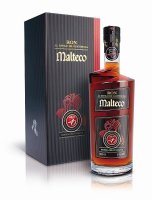Red wines from all over the planet (514)
Quality red wines from all over the world. Choose wine from 18 countries and over 2,500 types of world and Slovak wine brands. Quality red wines from all over the world. Choose wine from 18 countries and over 2,500 types of world and Slovak wine brands. Read more
Caliterra Reserva
Cabernet Sauvignonwine red - dry - r2022 - 0,75l
Finca Agostino
URBAN Cabernet Sauvignonwine red - dry - r2022 - 0,75l
Red wines from all over the planet
There is hardly any other drink that enjoys such popularity. There are more than a thousand varieties and each has its own character. Did you know that red wine has accompanied man for 8000 years? Since the days of Persia in the Middle East, the Greek sailors who planted them along the Mediterranean and the Romans who brought them to Europe? Therefore, red wine has been an almost integral part of special occasions or for a relaxing evening from time immemorial. Red wines from the French regions of Bordeaux and Burgundy, Italy, Spain, Portugal, Australia, New Zealand, America and South Africa are well-known.
How is red wine made?
Like white wine, red wine is basically nothing more than fermented grape juice. The pulp of the blue varieties does not have a red color, it gets into the juice by fermentation. In the case of white wine, the juice from the white grapes is pressed directly, the juice from the blue varieties together with the skins are in one container. When the mash is fermented, sugars are converted into alcohol and carbon dioxide. In the case of red wine, dyes, phenols and tannins are additionally extracted from the skins. During the process, the mass circulates, so the juice is not too hot and more color gets into the wine. After one to four weeks, the juice is pumped into stainless steel tanks or wooden barrels. During maturation, a second fermentation often takes place, the so-called malolactic fermentation. Hard malic acid turns into softer lactic acid. Almost every red wine goes through this process. In the northern wine-growing areas, which also includes Slovak wine-growing, the content of malic acid in grapes is higher.
Slovakia is more a country of white wine. The reason is of course the significantly colder climate compared to Italy or Spain. Thanks to the changing climate, conditions for blue varieties have improved in Slovakia. Some of them can even compete with their European relatives, especially the Frankovka blue, which enjoys popularity. The Danube makes certain demands on the area. It does particularly well in the classic locations of southern Slovakia.
What are the best red wines?
When it comes to the reputation of European red wines, France, Italy and Spain are the leaders, but the wines from Germany and Austria, Hungary and Slovenia are interesting. Wines from Bordeaux, Tuscany and Rioja are popular with Slovak customers. Piedmont with Prunotto Bussia Barolo, Cantina Di Negrar with Amarone della Valpolicella or Chianti Classico from Antinori are worth tasting, you will probably add them to your favorites. For a long time, only those from Bordeaux have been considered high-quality red wines from France.
It is one of the best wine growing regions in the world. The terroir and its stony soils, warm summers and mild winters make Bordeaux, next to Burgundy, the best French wine region. The Garonne and Dordogne rivers irrigate and temper the area along with the humid Atlantic. On an area of 113,000 hectares, mainly the blue varieties Cabernet Sauvignon, Cabernet Franc, Merlot, Petit Verdot, but also the white varieties Sauvignon Blanc, Sémillon and Muscadelle are grown.
With many wine regions, Italy is definitely something of a paradise for red wines. From sunny Puglia to the vineyards on the alpine slopes, Alto Adige is definitely one of the best places. Of course, Tuscany comes as the first region.
Which red wines are the best? The French term "Cépages nobles" unofficially forms the highest league of the most important wine varieties in the world. No wonder French vineyards are at the top here, including Cabernet Sauvignon and Merlot. Cabernet Sauvignon produces dark red wines. The aroma is dominated by black currants. On the other hand, Merlot, like Cabernet Franc, produces a diverse range of herbal and fruity flavors such as plums, raspberries, black currants and black pepper. Syrah is grown in France, especially near the Mediterranean Sea, more precisely in Languedoc-Roussillon and the Rhône. It has good ripening potential and is definitely one of the best world varieties in the world. Pinot Noir is recognized in Slovakia by the name Pinot Noir. He does best in Burgundy. It is an excellent ambassador of its location because it is very sensitive to soil conditions and climate. Italian Primitivo is very popular in Slovakia. By the way, you can buy the best of these rich red wines at wineplanet.sk. Unlike Primitiva, the Tempranillo equivalent from Spain's Rioja is also widely popular. Rather a maturing grape with firm skins, this variety produces intense, deep red wines with moderate acidity and fine tannins. Spices, coconut, leather, tobacco and strawberries are typical for Tempranillo. Like Merlot, Cabernet Sauvignon and Syrah, it ages well in oak barrels.
Which red wine harmonizes with food?
In order to answer the eternal question of which wine should be served with which food, without becoming dogmatic, there are a few rules. Whoever invites guests to a meal will probably follow the second rule, which is to present local food with local wine. Food and wine pairing basics can be found here! Those who take these small steps into account have a good chance of impressing their guests not only with their cooking skills, but also with the right choice of wine.
The kitchen is much warmer in summer than in winter, but that should not be a reason to avoid red wine. Dishes with veal or poultry go well with Frankovka blue, St. Lawrence, but Blue Portugal served at a temperature of 14 to 16 degrees is also excellent. Roast lamb goes well with Pinot Noir.
Full, rich and quality
Amarone from Cantina Di Negrar is a special case. 70% of the mixture consists of Corvina, which is grown on the traditional Pergoletta Doppia. The grapes are dried for 4 months in ventilated areas. The barrels in which the wine matures originate from France. The extract does not tire, but on the contrary brings pleasure. Sweet fortified wines from Graham's Winery are becoming increasingly popular.




 facebook
facebook
 Contact us
Contact us






